The Katsura Imperial Villa
| Photo |
Description |
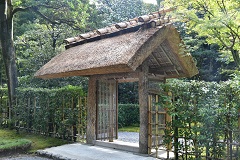 |
Some buildings cannot be seen from June 2021 to November 2023 due to repair work.
- Miyukimon Gate
- The original Miyukimon Gate was built on the occasion of the visit of the Emperor Emeritus Gomizuno-o in the mid-17th century. The present gate was rebuilt in the 18th century. The roof is thatched with reeds, and the posts are trunks of a kind of cork tree called abemaki.
|
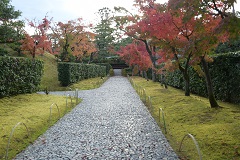 |
- Miyukimichi Path
- The Miyukimichi Path is paved with small stones. As those stones look like hailstones, the path is called “Ararekoboshi (scattered hailstones)”.
|
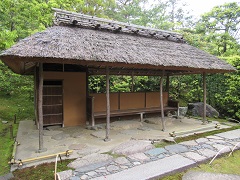 |
- Sotokoshikake Outdoor Bench
- Sotokoshikake is an arbor bench with a thatched roof and was used as a waiting place for tea ceremony gathering at the Shokintei pavilion. “Sunasettin” (sand toilet) is situated on the corner.
The thatched roof was repaired. The deteriorated parts was reroofed.
https://sankan.kunaicho.go.jp/info/pdf/sotokoshikake-kouji.pdf
(Open this content in a new window)
|
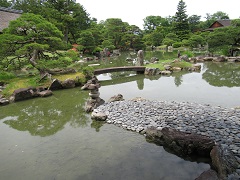 |
- Suhama Shore
- Black flat pebbles are paved onto the Suhama shore, which juts out into pond with a stone lantern at the end. The view is considered to represent a light house on the cape.
|
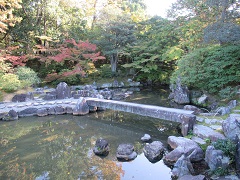 |
- Stone Bridge
- The stone slab bridge called Shirakawa Bashi Bridge leads to the Shokintei pavilion.
|
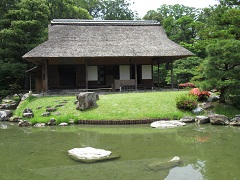 |
- Shokintei
- The Shokintei is the most prestigious tea pavilion in the Villa. The thatched roof is in the Irimoya (hip and gable roof) style.
|
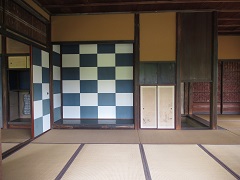 |
- The first room of the Shokintei
- Ichinoma, or the first room, has an indigo and white check-patterned paper on the sliding door and tokonoma (alcove).
|
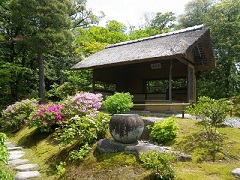 |
- Shokatei
- The Shokatei, which has a thatched and gable roof, is located on the highest point in the villa and is called “Touge-no-chaya”, which means “a tea house on a mountain path”
The thatched roof was repaired. The deteriorated parts was reroofed.
The work was completed in March 2022.
https://sankan.kunaicho.go.jp/info/pdf/shokatei-kouji.pdf
(Open this content in a new window)
|
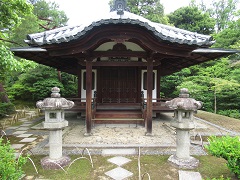 |
- Onrindo
- With a pyramidal tiled roof, this is the pavilion in which a statue of Kannon Bodhisattva and a portrait of Hosokawa Yusai had been enshrined initially. Later, the ancestral mortuary tablets of the successive princes of the family were also enshrined here. However, only the building remains today.
|
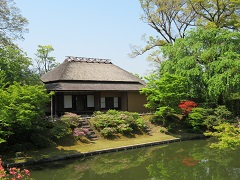 |
- Shoiken
- The Shoiken was designed to resemble a farm house. The roof is thatched with reeds and its eaves thatched with shingles.
|
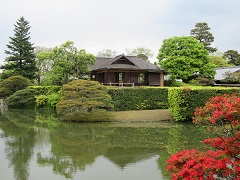 |
- Gepparo
- The Gepparo literally means “the Pavilion of the Moon and Ripples”. As the name implies, the Gepparo is the pavilion where visitors used to enjoy viewing the moon and the reflection of the moon on the pond.
|
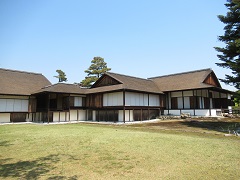 |
- Complex of the Shoin Palaces
- This complex of the Shoin palaces is the main building in the Katsura Imperial Villa. The Koshoin (Old Shoin Palace), the Chushoin (Middle Shoin Palace) and the Shingoten (New Palace) are arranged in a diagonal and staggered line like a flock of geese in flight. The moon viewing veranda is attached to the Koshoin Old Shoin Palace.
The complex of the Shoin palaces is under repair. This is to repair the deteriorated parts of the shingled roof, the plastered wall, and the furnishings. The work is scheduled to be completed in November 2023. During the period, the complex is partially covered in a scaffolding.
https://sankan.kunaicho.go.jp/info/pdf/shoin-kouji.pdf(Open this content in a new window)
|
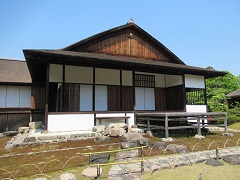 |
- Tsukimidai, the moon-viewing veranda
- The veranda, which juts out like a stage, was for a moon viewing. The platform of the veranda is made of bamboo.
|
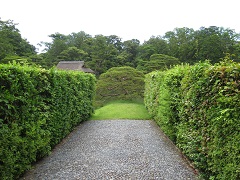 |
- Sumiyoshi Pine Tree
- This pine tree acts as the screen that blocks a long-range view of the garden.
|
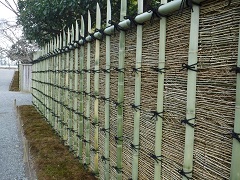 |
- Hogaki Fence
- The Hogaki Fence is made of big bamboo posts and bamboo twigs which are piled up between those bamboo posts.
|














